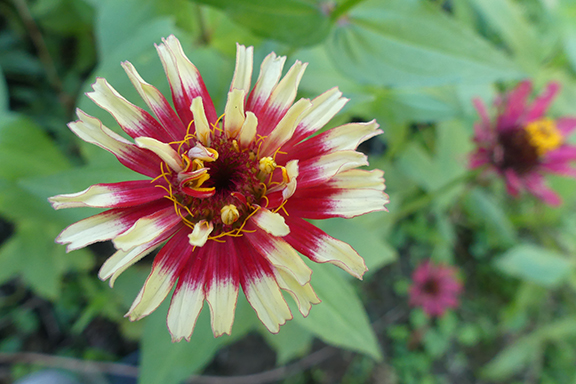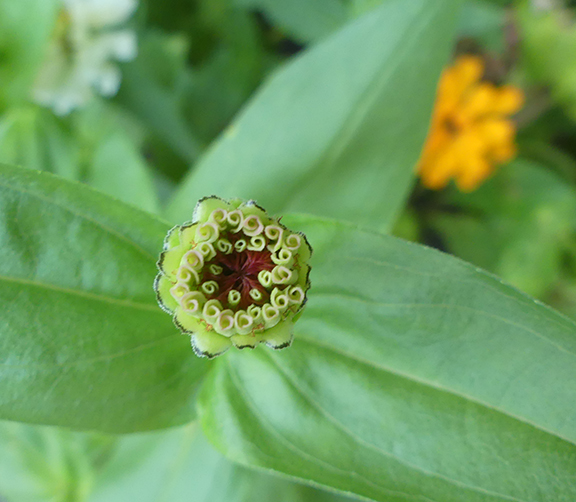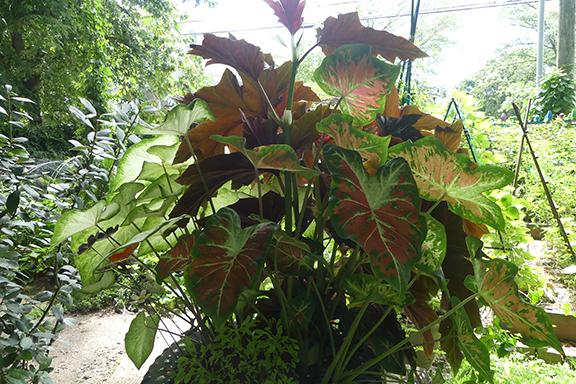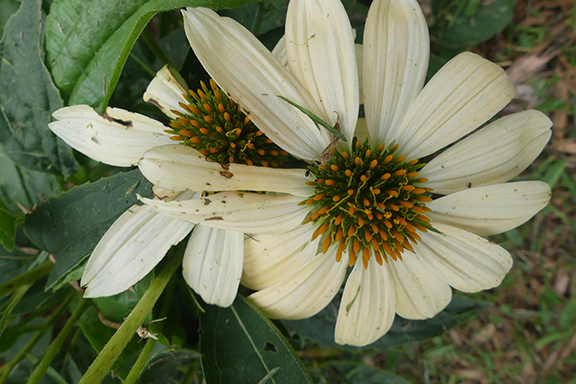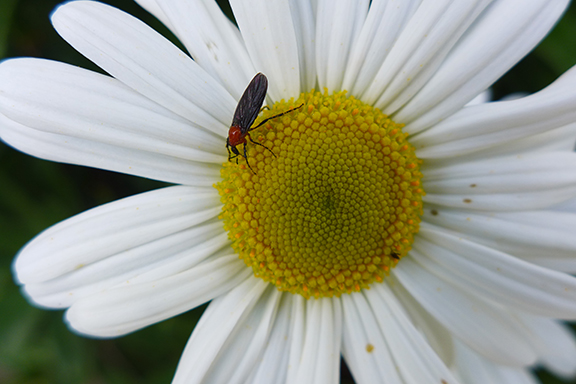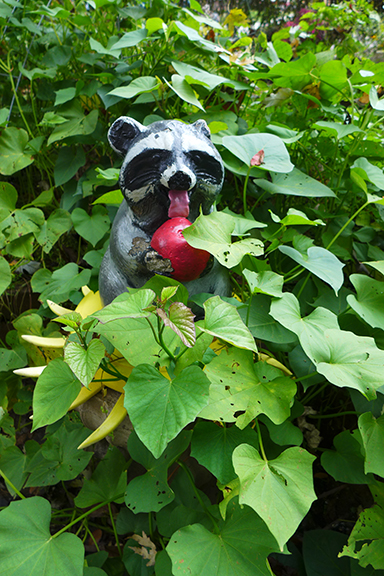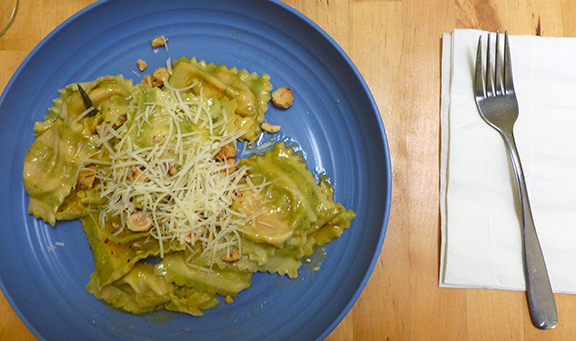October finally saw summer turn to autumn. I started the month by cleaning out the mass of plants in my vegetable garden. By that point, the tomatoes and melons were pretty rough looking. There were several melons to pick, but not many tomatoes anymore. There were also some pretty Klee’s orange marigolds mixed in. Covering it all was a mass of Mexican sour gherkin vines. They’re so cute and fun to grow, but, sadly, I didn’t get inspired to use them in anything this year, so they just grew and grew and never got picked. Next year my garden will be swarming with them because so many unpicked fruits fell on the ground everywhere.
Once the mass of plants was out of the way, I planted my garlic. I always think I have a great new plan for how I can plant garlic so that I’ll be able to plant something else around it in order to maximize the little space I have. But it never works that well. I always get the Small Garden Sampler from Southern Exposure Seed Exchange. It’s four different kinds of garlic. This time around, I thought I could plant four rows lengthwise in the raised bed. Surely that would be enough space, right? Well, a couple of the kinds of garlic had lots of small cloves in each head, so there were a lot to plant and they took up more like three rows each. I couldn’t throw any out, so I planted them all and, like usual, hoped something will work out brilliantly next spring. I don’t know what that solution will be, but I’ve got several months before it’s a problem.
Mid month, the overnight temperatures started to regularly be below 50 degrees and that meant it was time to bring in my houseplants for the winter and to harvest my basil. I’d used leaves of the basil here and there all summer, but at the end of the season I always pick everything and turn it into pesto. I made three rounds of pesto and froze most of it. We did use some as the bottom layer on a few pizzas, covering it with fresh mozzarella, pizza cheese, and roasted red pepper. It was delicious!
All month, my garden was brightened with a lot of blooms. Most of them were zinnias and marigolds, but there were also morning glories on the back fence (the kind that come up on their own and not the fancy kinds I planted, not that I noticed (I did)) and tassel flowers by the front bottle tree. I also had pretty blooms from a daisy-like chrysanthemum located by our front steps. You’ll see photos of the flowers here, but not of the plant. It got really leggy and not very attractive. I need to keep working on my mum-growing technique. The last half of the month was time for some of my favorite flowers to bloom–toad lilies. I love how bright, new, and fancy they look just when everything else is getting kind of tired and brown as it coasts into fall.
Toward the end of the month, I tried a project I’d always meant to do: using cement to make casts of big leaves and using those casts as stepping stones. The leaves on my elephant ears are always so beautiful and I’m sad every year when the frosts come. They’re the perfect leaves to turn into stepping stones, and now I can keep them year-round. I made five stones, plus a first one that turned out ok but not great. Next year I may try to add some color to them. For now I’m glad to have finished them before the frost destroyed the leaves (but not long before the frost so the plants didn’t look chopped up for long).
Another project at the end of the month was a round of garden-fresh ravioli. I hadn’t made any ravioli all summer and I decided that that needed to be remedied. Made from scratch, it’s absolutely delicious, but it’s also a lot of work. This time I made it even more work by attempting the fancy, multi-colored pastas that I’ve seen people making on the internet. I needed some natural coloring, so I used the one brightly colored thing I still had in my garden: sweet potato leaves. I cooked the leaves and pureed them and added them into some of the pasta dough to make striped dough. It was a lot tougher to do than they make it appear in internet videos. The pasta was stuffed with a cheesy, garlicy, roasted squash mixture. The squash and garlic were both from my garden. The pasta was served in a brown butter and sage sauce. It was sublime, but took most of the day to make.
Overall, the month was a little dry and quite warm. There were multiple weeks I decided to use my sprinklers to water because we didn’t get nearly enough rain. And our air conditioning was on for a lot of the time while the heat was only on for the last couple days (we tried to engage in the local sport of holding out till at least November before turning the heat on, but we quit when the temperature indoors didn’t get above 62 degrees for the day). There were no frosts and no temperatures near or below freezing, so most of my plants were still going strong at the end of the month.
John and I have been talking about how much we need to take more time off to help us cope with the stress of the pandemic and work. Then I saw a reason to take a long weekend away. There’s a place in Southern Illinois called Scratch Brewing. One of my Facebook friends wrote about visiting it a couple years ago, and I’ve wanted to go there ever since. They use all kinds of locally foraged plants in their brewing. I was intrigued but we never actually went there. Then Scratch’s announcement about their Octoberfest popped into my Facebook feed, and I decided it was time to visit.
We organized a couple days around our visit to Scratch. We found a cabin nearby where we could stay for a couple nights and drove out on a Friday so we could be at Scratch when they opened on Saturday. It was fantastic! The flavors were incredibly complex and layered. Some were surprising. All of them were fantastic. It was a cool, rainy day and was absolutely perfect for sitting in their outdoor dining area sampling all their drinks and eating good food. We spent several hours leisurely drinking and eating. All of it was created with an eye for what’s local. It was SO GOOD, and we can’t wait to go back.





































































































































































































































































































































































































































































































































































